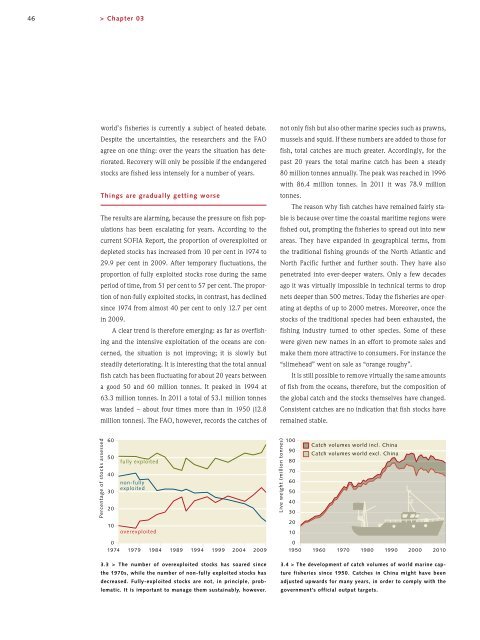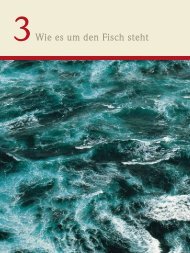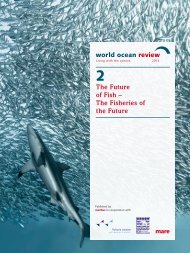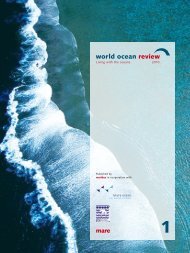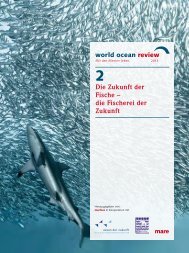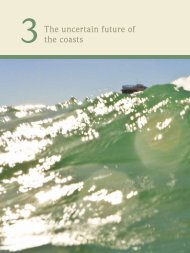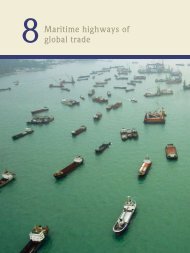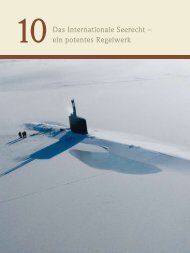Download PDF > Chapter 3 - World Ocean Review
Download PDF > Chapter 3 - World Ocean Review
Download PDF > Chapter 3 - World Ocean Review
- No tags were found...
Create successful ePaper yourself
Turn your PDF publications into a flip-book with our unique Google optimized e-Paper software.
46> <strong>Chapter</strong> 03world’s fisheries is currently a subject of heated debate.Despite the uncertainties, the researchers and the FAOagree on one thing: over the years the situation has deteriorated.Recovery will only be possible if the endangeredstocks are fished less intensely for a number of years.not only fish but also other marine species such as prawns,mussels and squid. If these numbers are added to those forfish, total catches are much greater. Accordingly, for thepast 20 years the total marine catch has been a steady80 million tonnes annually. The peak was reached in 1996with 86.4 million tonnes. In 2011 it was 78.9 millionThings are gradually getting worsetonnes.The results are alarming, because the pressure on fish populationshas been escalating for years. According to thecurrent SOFIA Report, the proportion of overexploited ordepleted stocks has increased from 10 per cent in 1974 to29.9 per cent in 2009. After temporary fluctuations, theproportion of fully exploited stocks rose during the sameperiod of time, from 51 per cent to 57 per cent. The proportionof non-fully exploited stocks, in contrast, has declinedsince 1974 from almost 40 per cent to only 12.7 per centin 2009.A clear trend is therefore emerging: as far as overfishingand the intensive exploitation of the oceans are concerned,the situation is not improving; it is slowly butsteadily deteriorating. It is interesting that the total annualfish catch has been fluctuating for about 20 years betweena good 50 and 60 million tonnes. It peaked in 1994 at63.3 million tonnes. In 2011 a total of 53.1 million tonneswas landed – about four times more than in 1950 (12.8million tonnes). The FAO, however, records the catches ofThe reason why fish catches have remained fairly stableis because over time the coastal maritime regions werefished out, prompting the fisheries to spread out into newareas. They have expanded in geographical terms, fromthe traditional fishing grounds of the North Atlantic andNorth Pacific further and further south. They have alsopenetrated into ever-deeper waters. Only a few decadesago it was virtually impossible in technical terms to dropnets deeper than 500 metres. Today the fisheries are operatingat depths of up to 2000 metres. Moreover, once thestocks of the traditional species had been exhausted, thefishing industry turned to other species. Some of thesewere given new names in an effort to promote sales andmake them more attractive to consumers. For instance the“slimehead” went on sale as “orange roughy”.It is still possible to remove virtually the same amountsof fish from the oceans, therefore, but the composition ofthe global catch and the stocks themselves have changed.Consistent catches are no indication that fish stocks haveremained stable.Percentage of stocks assessed6050403020fully exploitednon-fullyexploitedLive weight (million tonnes)10090807060504030Catch volumes world incl. ChinaCatch volumes world excl. China10overexploited201001974 1979 1984 1989 1994 1999 2004 200901950 1960 1970 1980 1990 2000 20103.3 > The number of overexploited stocks has soared sincethe 1970s, while the number of non-fully exploited stocks hasdecreased. Fully-exploited stocks are not, in principle, problematic.It is important to manage them sustainably, however.3.4 > The development of catch volumes of world marine capturefisheries since 1950. Catches in China might have beenadjusted upwards for many years, in order to comply with thegovernment’s official output targets.


